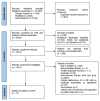Machine Learning and Artificial Intelligence for Infectious Disease Surveillance, Diagnosis, and Prognosis
- PMID: 40733500
- PMCID: PMC12299889
- DOI: 10.3390/v17070882
Machine Learning and Artificial Intelligence for Infectious Disease Surveillance, Diagnosis, and Prognosis
Abstract
Advances in high-throughput technologies, digital phenotyping, and increased accessibility of publicly available datasets offer opportunities for big data to be applied in infectious disease surveillance, diagnosis, treatment, and outcome prediction. Artificial intelligence (AI) and machine learning (ML) have emerged as promising tools to analyze complex clinical and molecular data. However, it remains unclear which AI or ML models are most suitable for infectious disease management, as most existing studies use non-scoping literature reviews to recommend AI and ML models for data analysis. This scoping literature review thus examines the ML models and applications that are most relevant for infectious disease management, with a proposed actionable workflow for implementing ML models in clinical practice. We conducted a literature search on PubMed, Google Scholar, and ScienceDirect, including papers published in English between January 2020 and April 2024. Search keywords included AI, ML, public health, surveillance, diagnosis, prognosis, and infectious disease, to identify published studies using AI and ML in infectious disease management. Studies without public datasets or lacking descriptions of the ML models were excluded. This review included a total of 77 studies applied in surveillance, prognosis, and diagnosis. Different types of input data from infectious disease surveillance, clinical diagnosis, and prognosis required different ML and AI models to achieve the maximum performance in infectious disease management. Our findings highlight the potential of Explainable AI and ensemble learning models to be more broadly applicable in different aspects of infectious disease management, which can be integrated in clinical workflows to improve infectious disease surveillance, diagnosis, and prognosis. Explainable AI and ensemble learning models can be suitably used to achieve high accuracy in prediction. However, as most of the studies have not been validated in different cohorts, it remains unclear whether these ML models can be broadly applicable to different populations. Nonetheless, the findings encourage deploying ML and AI to complement clinicians and augment clinical decision-making.
Keywords: artificial intelligence; diagnosis; infectious diseases management; machine learning; prognosis; surveillance.
Conflict of interest statement
The authors declare no conflicts of interest.
Figures





Similar articles
-
Research status, hotspots and perspectives of artificial intelligence applied to pain management: a bibliometric and visual analysis.Updates Surg. 2025 Jun 28. doi: 10.1007/s13304-025-02296-w. Online ahead of print. Updates Surg. 2025. PMID: 40580377
-
A Systematic Review and Bibliometric Analysis of Applications of Artificial Intelligence and Machine Learning in Vascular Surgery.Ann Vasc Surg. 2022 Sep;85:395-405. doi: 10.1016/j.avsg.2022.03.019. Epub 2022 Mar 24. Ann Vasc Surg. 2022. PMID: 35339595
-
The Use of Deep Learning and Machine Learning on Longitudinal Electronic Health Records for the Early Detection and Prevention of Diseases: Scoping Review.J Med Internet Res. 2024 Aug 20;26:e48320. doi: 10.2196/48320. J Med Internet Res. 2024. PMID: 39163096 Free PMC article.
-
The Use of Machine Learning for Analyzing Real-World Data in Disease Prediction and Management: Systematic Review.JMIR Med Inform. 2025 Jun 19;13:e68898. doi: 10.2196/68898. JMIR Med Inform. 2025. PMID: 40537090 Free PMC article.
-
Approaches for predicting dairy cattle methane emissions: from traditional methods to machine learning.J Anim Sci. 2024 Jan 3;102:skae219. doi: 10.1093/jas/skae219. J Anim Sci. 2024. PMID: 39123286 Free PMC article.
References
-
- Gray A., Sharara F. Global and regional sepsis and infectious syndrome mortality in 2019: A systematic analysis. Lancet Glob. Health. 2022;10:S2. doi: 10.1016/S2214-109X(22)00131-0. - DOI
-
- Global Burden of Disease Study 2019 (GBD 2019) Data Resources. Institute for Health Metrics and Evaluation. 2019. [(accessed on 19 April 2024)]. Available online: https://ghdx.healthdata.org/gbd-2019.
-
- Basto-Abreu A., Barrientos-Gutierrez T., Wade A.N., Oliveira de Melo D., Semeão de Souza A.S., Nunes B.P., Perianayagam A., Tian M., Yan L.L., Ghosh A., et al. Multimorbidity matters in low and middle-income countries. J. Multimorb. Comorbidity. 2022;12:263355652211060. doi: 10.1177/26335565221106074. - DOI - PMC - PubMed
Publication types
MeSH terms
Grants and funding
LinkOut - more resources
Full Text Sources
Medical
Miscellaneous

